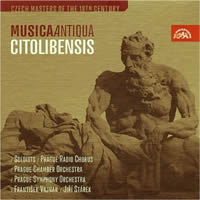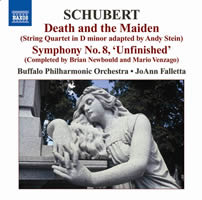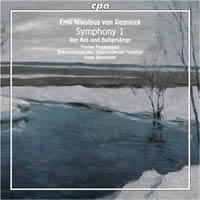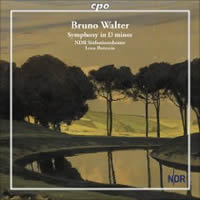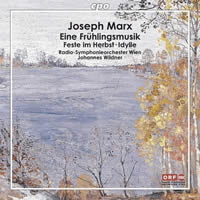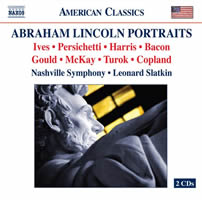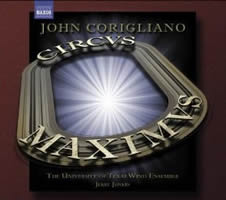Mostly Symphonies 11.
|
Grant Chu Covell [June 2009.]
“Musica Antiqua Citolibensis.” Var. comps by Jan Adama GALLINA, Karel Blažej KOPŘIVA, Jan VENT, Václav Jan KOPŘIVA, Jan Jáchym KOPŘIVA and Jakub LOKAJ. Var. soloists, Prague Radio Chorus, Prague Chamber Orchestra, Prague Symphony Orchestra, František Vajnar, Jiŕí Stárek (conds.). Supraphon SU 3908-2 (4 CDs) (http://www.supraphon.com/). Distributed in the US by Qualiton (http://www.qualiton.com/). This revealing 2007 compilation reaches back to recordings from 1966-67 and 1983-84, which opened a largely neglected chapter of Czech music. The early-Classical bounty consists in the main of masses, motets and arias for soloists, chorus and orchestra garnished with organ fugues (K.B. Kopřiva) and one wind quintet (J. Vent), all of which were written for the town of Citoliby in northwestern Bohemia, 60 km (37 mi.) from Prague. Far from languishing in a backwater, Citoliby’s composers were well apprised of activity in Vienna and Naples. Oboist / composer / arranger Jan Vent was known to Salieri and Mozart. While the impatient may well argue that this music is provincial, it’s a good deal more than competent, and the performances are sincere. Father (Václav Jan) and son (Karel Blažej) Kopřiva dominate these four discs. The former’s Missa Pastoralis is particular stirring, and the latter’s organ fugues offer exciting contrast. Jan Adama Gallina’s graceful Classical symphonies merit further exploration. One hears connections between Kecal’s Act I aria in Smetana’s Bartered Bride (1866), “Jak vám pravím, pane kmotře,” (As I’m saying, my dear fellow) and the elder Kopřiva.
Franz SCHUBERT: String Quartet in D minor, D. 810, “Death and the Maiden” (1824; arr. Andy Stein); Symphony No. 8 in B minor, D. 759, “Unfinished” (1822; Scherzo compl. Brian Newbould; Finale from Rosamunde, ed. Mario Venzago). Buffalo Philharmonic Orchestra, JoAnn Falletta (cond.). Naxos 8.572051 (http://www.naxos.com/). One of the Eternal Questions: What would have happened if Schubert had not died so young? As if to speculate, this recording pairs an arrangement of the 14th string quartet with a completed B-minor symphony. In Andy Stein’s prosaic instrumentation, the quartet fails to come alive. Mahler’s far preferable string-orchestra arrangement hews more closely to the original’s scoring, thus honoring Schubert’s intentions. Following the two iconic B-minor movements, we’re treated to Brian Newbould’s scherzo completion as foreshadowing Bruckner’s bucolic rhythms and contrasts. A finale is fashioned from the first entr’acte of Rosamunde, which certain scholars think may have been this symphony’s conclusion. The Buffalo Philharmonic, which plays energetically enough, could have profited from a touch more refinement.
Franz SCHMIDT: Symphony No. 1 (1899); excerpts from Notre Dame, Op. 2 (1914). Malmö Symphony Orchestra, Vassily Sinaisky (cond.). Naxos 8.570828 (http://www.naxos.com/). Schmidt’s First premiered in Vienna in 1902 under its composer’s direction. Its positive reception further soured relations between Schmidt and Mahler whose own symphonies were struggling for acceptance. There was also tension between Mahler the conductor and Schmidt the orchestral cellist when he wasn’t promoted to principal. Bearing evidence of Brahms and Bruckner’s influence, Schmidt’s 45-minute First is a grand affair, with its sturdy footwork and Wagnerian grandeur. Subtlety is hard to find in a symphony the ending of which is a close match to the grandiose pomp of Stokowski’s Bach transcriptions. Considering this First alongside a recent Das Buch mit sieben Siegeln (Chandos CHSA5061) suggests why Mahler’s neurotic fare did not flourish in his day, whereas his Eighth met with such acclaim. Three distinctive opera excerpts, Introduction, Intermezzo and Carnival Music, works of Schmidt’s maturity, indicate a heightened sense of fluidity.
Emil Nikolaus von REZNICEK: Symphony No. 1, “Tragic” (1902); Vier Buß- und Betgesänge (1913). Marina Prudenskaja (mez-sop), Brandenburgisches Staatsorchester Frankfurt, Frank Beermann (cond.). cpo 777 223-2 (http://www.cpo.de/). Distributed in the US by Naxos (http://www.naxos.com/). Reznicek’s 55-minute First bubbles with ideas. Other than de rigueur late-Romantic Sturm und Drang, there’s nothing especially tragic here. Indeed the moniker is more applicable to the Four Songs of Prayer and Repentance after Words of the Holy Scriptures, which are stern and severe. By comparison, the symphony is flippant. To my ears, the symphony’s opening overtly borrows from Liszt’s B-minor sonata. In fact, Reznicek’s reliance on Liszt and Beethoven startles mightily once such thematic coincidences make their presence known. A whirlwind scherzo precedes a grand slow movement with red-carpet Wagnerian fanfares. The finale boasts an African theme that nowadays seems merely rhythmic and mildly modal. Reznicek’s friskiness awkwardly fits his Teutonic palette, and the enjoyable, meekly developed themes largely exist as exercises in new instrumentation. Reznicek’s Second and Fifth are covered here.
Bruno WALTER: Symphony No. 1 in D minor (1906-07). NDR Sinfonieorchester, Leon Botstein (cond.). cpo 777 163-2 (http://www.cpo.de/). Distributed in the US by Naxos (http://www.naxos.com/). We remember Walter as a conductor for good reason. As a composer, he assembles an assortment of expressionistic chords and effects, but the strategies and goals of symphonic structure — this four-movement First swells to 59:30 — clearly elude him. Playing the work for Mahler, Walter took his mentor’s dismissal in stride, completed a Second shortly after (ca. 1910), and then stopped composing. The symphony’s best movement is a formulaic but effective Allegro con brio waltz-scherzo. Botstein and his players do as well as can be expected.
Joseph MARX: Eine Frühlingsmusik (1925); Idylle (1925); Feste im Herbst (1946). Radio-Symphonieorchester Wien, Johannes Wildner (cond.). cpo 777 320-2 (http://www.cpo.de/). Distributed in the US by Naxos (http://www.naxos.com/). Eine Frühlingsmusik erupts like caffeinated Strauss before settling into honeyed romanticism. Marx’s “Spring Music” tends to ramble, but who’d mind an overstaying spring? The impressionistic Idylle adds a light moment. Completed two decades later in very different times, Feste im Herbst strikes the listener as gushing Germanic Puccini with tinselly xylophone thrown in for good measure. These orchestral works could pass for film scores — surprising, given Marx’s earnest piano music and his command of diverse styles. From the evidence, Marx was a talented chameleon — witness the Romantic Piano Concerto (Hyperion CDA66990). A recording of his putative masterpiece, Eine Herbstsymphonie, ought to show up soon.
“Abraham Lincoln Portraits.” Charles IVES: Lincoln, the Great Commoner (1912?). Vincent PERSICHETTI: A Lincoln Address, Op. 124 (1972). Roy HARRIS: Abraham Lincoln Walks at Midnight (1953). Ernst BACON: Ford’s Theatre: A Few Glimpses of Easter Week, 1865 (1946). Morton GOULD: Lincoln Legend (1941). George Frederick McKAY: To a Liberator (A Lincoln Tribute) (1939). Paul TUROK: Variations on an American Song: Aspects of Lincoln and Liberty, Op. 20 (1963). Aaron COPLAND: Lincoln Portrait (1942). Barry Scott (narrator), Sharon Mabry (mez-sop), Mary Kathryn Van Osdale (vln), Anthony LaMarchina (vlc), Roger Wiesmeyer (pno), Nashville Symphony Chorus, Nashville Symphony, Leonard Slatkin (cond.). Naxos 8.559373-74 (2 CDs) (http://www.naxos.com/). To commemorate his 200th birthday, this Naxos release consists of a varied program of works inspired by our 16th president. Beyond Copland’s compulsory Lincoln Portrait, the program’s unfamiliar pieces offer a little something for everyone. High points include Ives’ brief Lincoln, the Great Commoner for chorus and orchestra, and Ernst Bacon’s 12-part Ford’s Theatre: A Few Glimpses of Easter Week, 1865. In his scant four-minute setting, Ives cares little that the tunes are pleasing or even recognizable. He simply piles them on, leaving the listener to sort it all out. Bacon also works with Americana, offering arresting harmonic and rhythmic twists and turns. Harris’ Abraham Lincoln Walks at Midnight for mezzo and piano trio is tedious, self-indulgent pap. Someone should explain why these composers delight in tunes from Lincoln’s day rendered in a manner both grandiose and tonal — someone, that is, with greater patience than I.
John CORIGLIANO: Symphony No. 3 for large wind ensemble, “Circus Maximus” (2004); Gazebo Dances (1972). The University of Texas Wind Ensemble, Jerry Junkin (cond.). Naxos 8.559601 (http://www.naxos.com/). Oh, what a (Roman) circus! Corigliano’s Third for grand band envelops its audience in all sorts of stuff, intent on connecting today’s pop-culture decadence with the declining Roman Empire’s chariot battles and lion fights. The unabashedly stagy Channel Surfing movement jumps and cuts, with borrowed electronic touches that make sense here. A cadentially obsessed Prayer movement pursues serenity, and yet we know from earlier interruptions that tranquility will soon exit. The symphony ends with a gunshot. The University of Texas Wind Ensemble demonstrates delicate control in the traditionally scored Gazebo Dances.
Bacon, Copland, Corigliano, Gallina, Harris, Ives, Kopřiva, Lokaj, M Gould, Marx, McKay, Persichetti, Reznicek, Schmidt, Schubert, Turok, Walter
[More Grant Chu Covell, Mostly Symphonies]
[More
Bacon, Copland, Corigliano, Gallina, Harris, Ives, Kopřiva, Lokaj, M Gould, Marx, McKay, Persichetti, Reznicek, Schmidt, Schubert, Turok, Walter]
[Previous Article:
Musique de Chambre de Musique (l’Amérique et plus nord)]
[Next Article:
42 Amens]
|
